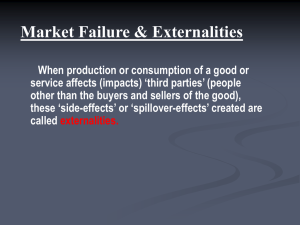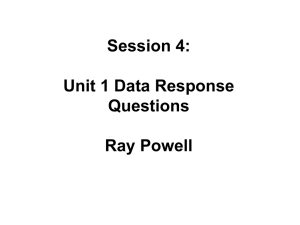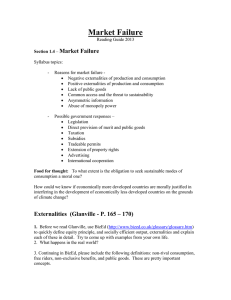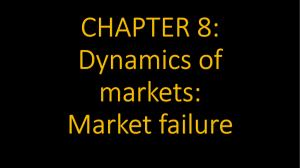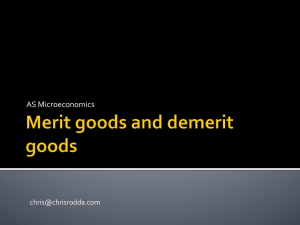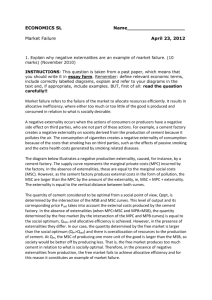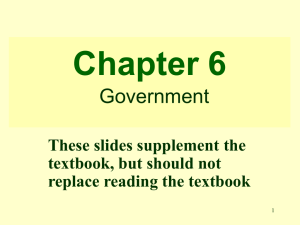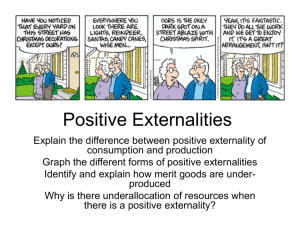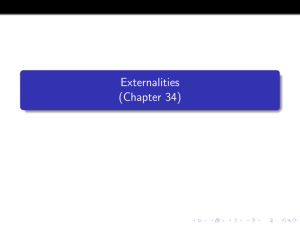Market Failure - Economics @ Tallis
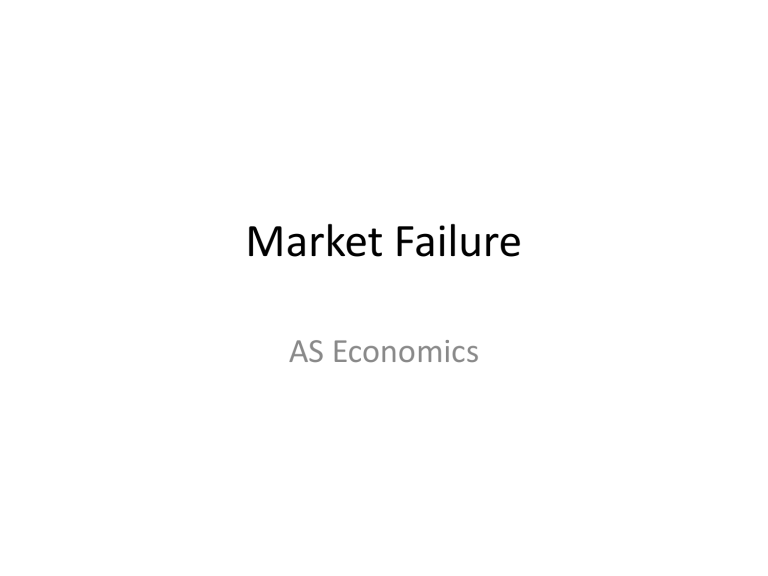
Market Failure
AS Economics
Market Failure – a definition
• Market failure occurs when the free market, left alone, fails to deliver an efficient allocation of resources. The result is a loss of economic and social welfare.
Causes of market failure
• Negative externalities e.g. pollution causing the social cost to exceed the private costs
• Positive externalities e.g. education causing the social benefit to exceed the private benefits
• Imperfect information meaning merit goods are underproduced and demerit goods are over-produced
• The private sector being unable to supply important public and quasi-public goods
• Market dominance by monopolies
• Immobility of factors of production causes unemployment and productive inefficiency
• Equity (fairness) issues resulting in an unacceptable distribution of income and social exclusion
Activity 1
Which of the following would provide evidence of market failure?
a)shortages b)unemployment c) unfilled job vacancies d)output occurring inside the PPF
Market failure and economic efficiency
• MF results in productive inefficiency
• Firms are not maximising output from given factor inputs
• This is problematic as lost output could have been used to satisfy more needs and wants; resources are misallocated and producing goods and services not wanted by consumers
– resources could have been put to better use
Externalities
• Externalities are costs OR benefits that spill over to third parties external to a market transaction
Social costs or benefits
Externalities
Externality
– positive or negative depending on costs or benefits
Private
Costs or
Benefits
Activity 3
A public house is permitted to stay open all weekend over the May bank holiday. Identify one group of people not directly involved in running or visiting the pub who may: a)benefit from this decision b)suffer as a result of this decision
Negative externalities
• Private costs of any action are those suffered by the individual decision maker
• Social costs of any action are all the conceivable costs associated with that action
• If social costs exceed private costs then a negative
externality exists; the private optimum level of output is greater than the social optimum level of output – the individual or consumer does not take into account the effects of externalities into their calculations
• PC/SC are usually referred to in the ‘margin’ – the costs or benefits of one extra unit of output
• So, MSC = MPC + MEC
Positive externalities
• These arise when third parties benefit from the ‘spillover’ effects of production and consumption
• Education – improves skills and productivity –
PB of better for employers – earn more – SB – you increase living standards of the nation
• So, MSB = MPB + MEB
Activity 4
Identify: a)three private costs a bus company may incur when operating a bus rout b)two private benefits a newspaper company can gain from selling its newspapers
Activity 5
• Identify a benefit the other residents of a street could gain from one household holding a firework party to which they were not invited
Activity 6
• Identify three negative externalities which villagers may experience as a result of a bypass being built through their village
0
P
1
P
Negative externality
Q
1
Q
S
1
(MSC = MPC + MEC)
D
S (MPC)
Quantity
•At price P and demand/supply Q, only the private costs are taken into account
•If the external costs are taken into account then the supply curve would shift to the left to S
1
•Price would rise from P to
P
1
•Equilibrium quantity would fall from Q to Q
1
•The negative externality is
causing over-production of
Q-Q
1 and the price paid is lower than it should be
P
1
P
0
Positive externality
S (MPB)
•At price P and demand/supply Q, only the private benefits are taken into account
•If the external benefits are taken into account then the demand curve would shift to the right to D
1
•The market equilibrium would be at
Price P
1 and Quantity Q
1
• When the market fails to operate in this way there is under-production and this is shown by the difference between Q
1
Q and
•Too few scarce resources are being used hence the market failure
Q Q
1
D
1
(MSB = MPB + MEB)
D (MPB)
Quantity
Recap
• Negative externalities lead to over-production
• Positive externalities lead to under-production
• MSC = MPC + MEC
• MSB = MPB + MEB
Cheap food – at a huge price & questions
P91 - 92
Merit and Demerit goods
• Merit goods are more beneficial for consumers than they realise – usually have positive externalities. Governments usually subsidise these so consumption does not depend on ability to pay
• Left to market forces merit goods would be under-consumed and so under-produced
(underprovided)
• Demerit goods are more harmful for consumers than they realise – usually have negative externalities, and are over-provided
Activity 9
Decide whether the following are merit or demerit goods: a) heroin b) catalytic convertors c) insurance d) MOT tests e) public libraries f) education g) legal drugs h) healthcare i) tobacco j) vaccinations k) alcohol
Under-provision of a merit good
P
1
P
0
Q Q
1
S (MSC) •Demand (D) is based on an underestimate of the private benefits of a merit good.
•The full benefit to consumers and third parties is represented by the curve D
1
•Society would gain from increasing output from Q to Q1
D
1
(MSB = MPB + MEB)
D (MPB)
Quantity
Over-provision of a demerit good
S (MSC)
P
P
1
•Demand (D) is based on an overestimate of the private benefits of a demerit good.
•The full benefit to consumers and third parties is represented by the curve D
1
•A reduction in output from Q to Q1 would be a move towards a more efficient allocation of resources
0
Q
1
Q
D
1
D
Quantity

